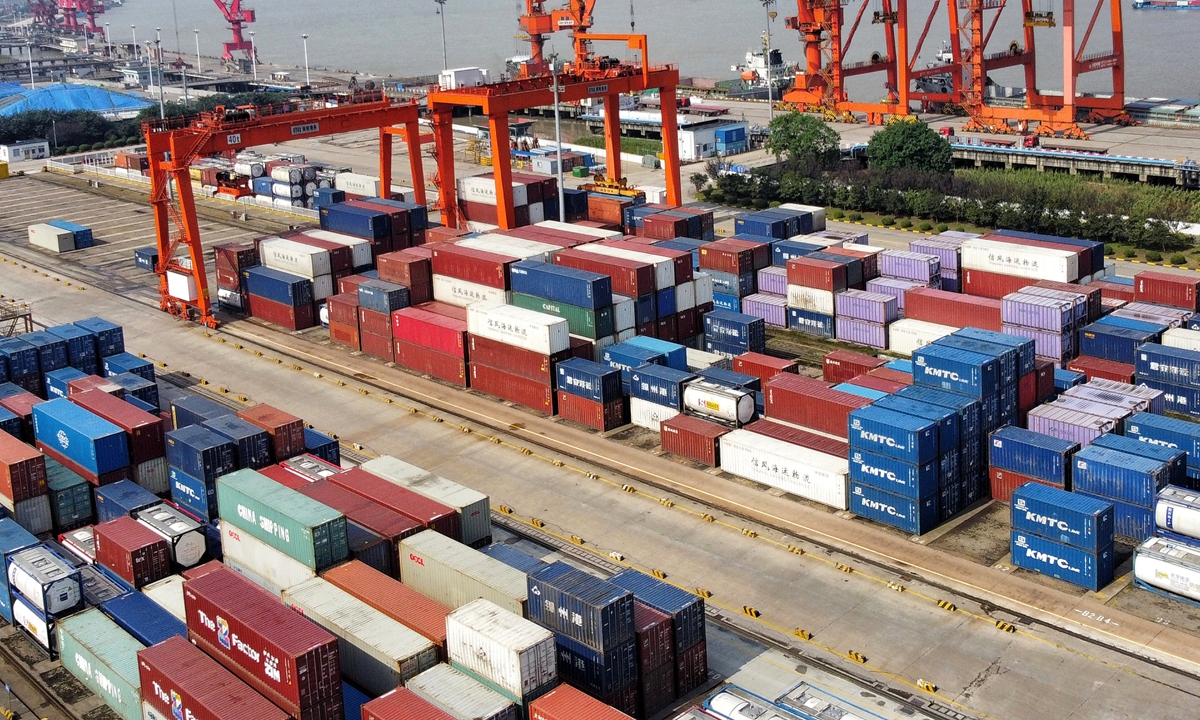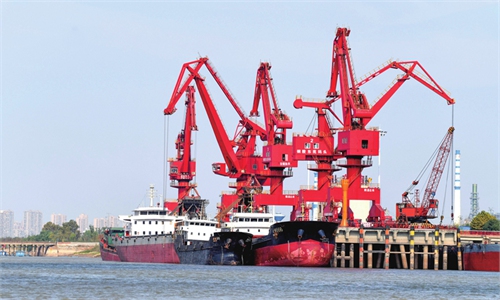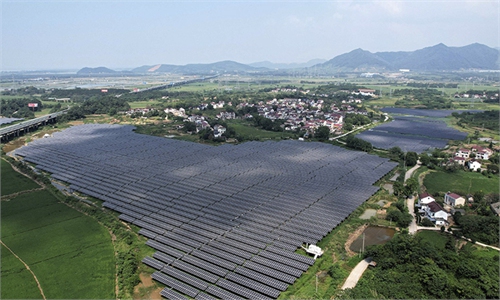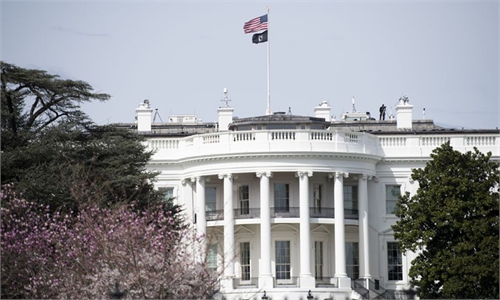
A view of the Zhangjiakou port in East China's Jiangsu Province on October 21. Photo: cnsphoto
China's trade growth with the US slowed in October compared with September, Chinese customs data revealed on Sunday, while the China-US phase one trade deal continues to move forward before the conclusion of the agreement approaches in January 2022.
Although bilateral trade increased 33.4 percent year-on-year to reach $66.794 billion from January to October, the growth rate dropped, compared with a 35.4-percent growth from January to September, according to customs data.
That sent China's trade surplus with the US to $40.75 billion in October, down from $42 billion recorded for September, according to calculations made by the Global Times.
China's import value from the US stood at $14 billion in August, rising to $15.4 billion in September but down to $13 billion last month.
China's macro regulatory policies on domestic economy and real estate sector resulted in slower growth across investment and consumption, leading to imports drop from the US, Tian Yun, former vice director of the Beijing Economic Operation Association, told the Global Times.
At present, global economy is suffering from supply chain snarls - China lacks energy and the US lacks goods, he noted. "Which country could stabilize domestic supply chains and boasts big share in global value chain will outperform in foreign trade."
Despite October statistics, the phase one trade agreement between China and the US is moving forward as China has increased its purchase of US energy products.
China's state-owned oil giant Sinopec on Thursday inked a massive deal with US' Venture Global LNG to buy 4 million tons of liquefied natural gas (LNG) annually for 20 years, the largest long-term LNG deal ever signed between the world's two largest economies.
China's energy imports grew year-on-year from January to October, with coal imports up 1.9 percent and natural gas up 22.3 percent, the customs data revealed.
A recent study by the US-China Business Council showed 64 percent of US Congressional districts exported more goods to China in 2020 compared with 2019, with 72 districts increasing their exports by more than $100 million. The uptick was particularly sharp in the farming communities of the Midwest, oil-exporting regions in Texas and Louisiana, and Oregon's semiconductor hub.
However, Trump's tariffs remain a big obstacle to hold back bilateral trade growth.
"If tariffs are cut or eliminated… China will increase imports and exports with the US, for sure. The country needs US energy products to help go through a cold winter and to ease domestic supply bottlenecks," Tian said.
Earlier this month, US Treasury Secretary Janet Yellen's comments on the US eventually lowering some tariffs on Chinese goods marks a positive sign in bilateral trade ties, which could be a significant step for the two countries to address one of their biggest and most damaging trade disputes -- tariffs, analysts said, suggesting practical actions could be implemented as soon as possible.
Global Times

A view of the Zhangjiakou port in East China's Jiangsu Province on October 21. Photo: cnsphoto
China's trade growth with the US slowed in October compared with September, Chinese customs data revealed on Sunday, while the China-US phase one trade deal continues to move forward before the conclusion of the agreement approaches in January 2022.
Although bilateral trade increased 33.4 percent year-on-year to reach $66.794 billion from January to October, the growth rate dropped, compared with a 35.4-percent growth from January to September, according to customs data.
That sent China's trade surplus with the US to $40.75 billion in October, down from $42 billion recorded for September, according to calculations made by the Global Times.
China's import value from the US stood at $14 billion in August, rising to $15.4 billion in September but down to $13 billion last month.
China's macro regulatory policies on domestic economy and real estate sector resulted in slower growth across investment and consumption, leading to imports drop from the US, Tian Yun, former vice director of the Beijing Economic Operation Association, told the Global Times.
At present, global economy is suffering from supply chain snarls - China lacks energy and the US lacks goods, he noted. "Which country could stabilize domestic supply chains and boasts big share in global value chain will outperform in foreign trade."
Despite October statistics, the phase one trade agreement between China and the US is moving forward as China has increased its purchase of US energy products.
China's state-owned oil giant Sinopec on Thursday inked a massive deal with US' Venture Global LNG to buy 4 million tons of liquefied natural gas (LNG) annually for 20 years, the largest long-term LNG deal ever signed between the world's two largest economies.
China's energy imports grew year-on-year from January to October, with coal imports up 1.9 percent and natural gas up 22.3 percent, the customs data revealed.
A recent study by the US-China Business Council showed 64 percent of US Congressional districts exported more goods to China in 2020 compared with 2019, with 72 districts increasing their exports by more than $100 million. The uptick was particularly sharp in the farming communities of the Midwest, oil-exporting regions in Texas and Louisiana, and Oregon's semiconductor hub.
However, Trump's tariffs remain a big obstacle to hold back bilateral trade growth.
"If tariffs are cut or eliminated… China will increase imports and exports with the US, for sure. The country needs US energy products to help go through a cold winter and to ease domestic supply bottlenecks," Tian said.
Earlier this month, US Treasury Secretary Janet Yellen's comments on the US eventually lowering some tariffs on Chinese goods marks a positive sign in bilateral trade ties, which could be a significant step for the two countries to address one of their biggest and most damaging trade disputes -- tariffs, analysts said, suggesting practical actions could be implemented as soon as possible.
Global Times



